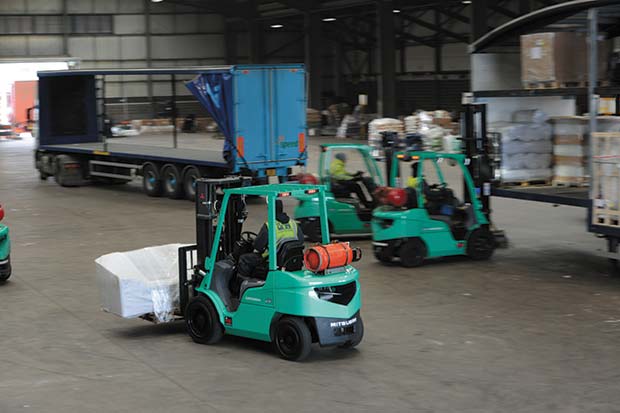When it comes to short-shuttle working, most operators are looking for the same things but Stewart Gosling from Red Diamond Distribution, UK importers of Mitsubishi forklift trucks, suggests starting with a blank sheet…
 In our experience, almost every specifier involved in short-shuttle operations has a similar wish-list: maximum fuel economy, very rapid cycle times, smooth, precise safe handling, predictability and great all round visibility. But most start with an assumption regarding motive power… and I’d suggest that this, too, should be an integral part of discussions.
In our experience, almost every specifier involved in short-shuttle operations has a similar wish-list: maximum fuel economy, very rapid cycle times, smooth, precise safe handling, predictability and great all round visibility. But most start with an assumption regarding motive power… and I’d suggest that this, too, should be an integral part of discussions.
Let’s take a look at the pros and cons for the two main alternatives: LP gas and electric.
Stick with LP Gas?
The LPG counterbalance is, without doubt, the weapon of choice in many hubs and other environments where achieving a rapid turnaround and multi shifts is the name of the game.
They want agility and they want operational economy – especially their responsibilities extend to managing transport fleets where fuel prices are monitored constantly with even the smallest shift in the price dramatically affecting profitability.
But let’s be clear, it’s not just the markets that can influence running costs. Not all forklifts are created equal when it comes to guzzling gas.
In a series of real-life comparative tests, a major UK company pitted the Mitsubishi GRENDiA ES against one of its biggest rivals. The results were astonishing:
From a single cylinder of LP Gas, the GRENDiA delivered 11.5 hours of work – while the competitor provided just 9.
In cash terms, that 28% superiority in fuel economy means a saving of £9500 per truck over a 5 year rental term.
Multiply that by 30 machines in the fleet and the economies are in excess of a quarter of a million pounds. That’s serious money and could mean the same work being accomplished with fewer machines and fewer operators – savings of around £65,000 per machine per year (plus fuel savings!) How is it achieved? In part it’s down to a state-of-the-art management system but also to the fact Mitsubishi is exceptional in employing purposedesigned industrial engines rather than those adapted from the automotive market. The result is high intensity performance and smooth yet very rapid acceleration.
That’s not all. These machines are likely to spend some time indoors, that engine comes with a closed-loop threestage catalytic convertor which dramatically reduces carbon monoxide and hydrocarbons emissions – as well as 95% of dangerous NOx gases… making it the cleanest running machine on the market.
Extending cleanliness still further, the GRENDiA ES incorporates – as standard – a factory-fitted belly guard. This serves two important purposes. Firstly, it stops damaging dust and debris getting caught in your engine and causing damage. Secondly, it prevents the ‘cyclone effect’ a phenomenon caused by conventional IC trucks which suck up dust and dirt and then circulate it throughout your warehouse.
So why with all that going on, why would you even consider an electric? … or twist to electric?
Thanks to the latest generation of fast, robust and weatherproof models, specifiers we speak to are looking, with greater interest than ever before, at battery-powered trucks for even the toughest applications. And why not? The latest generation of electric counterbalance forklifts, like the award-nominated EDiA EX from Mitsubishi, do everything that a gas or diesel truck can do… only cheaper, cleaner and more effectively. They similarly outperform hybrid alternatives which, in my experience are rapidly being recognised as being inefficient, complex, costly and an irrelevant compromise.
Getting back to the highperformance electrics, it’s true the initial purchase price may be slightly higher than an equivalent IC model. But, over a five-year rental contract in a demanding environment like distribution, lower fuel and maintenance costs typically result in an average saving in the region of 25% when compared with gas or diesel counterparts.
What’s more, with its unique, award-nominated steering geometry, the EDiA EX will not only outperform any IC truck but will outmanoeuvre it as well. Traditionally, a forklift truck’s steer wheels turn a maximum 90-degrees.
However, achieving this in the tightest turns forces the truck backwards placing high pressure on the tyres, as well as the rim.
This has been solved by EDiA’s engineers through a combination of intelligent software and counterrotating drive wheels, which deliver a unique four- wheel steering geometry, making it extremely agile in tight spaces.
Again, unlike any competitor, its rear axle turns through 100 degrees adding even further to its exceptional manoeuvrability.
MITSUBISHI
Tel: 0845 371 3048




Comments are closed.